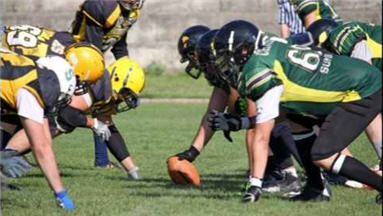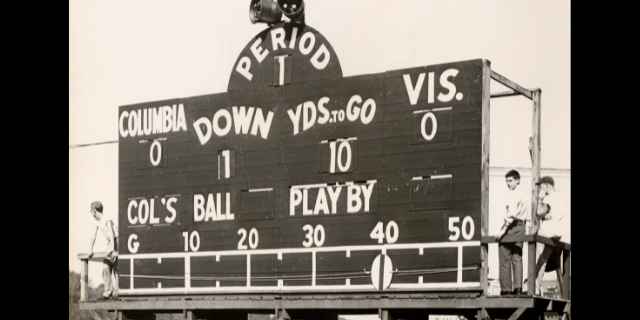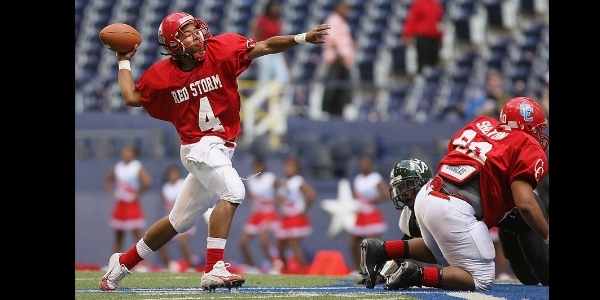As a rugby fan, I used to believe that American Football evolved from rugby in U.S. colleges. I asked an American fan of both sports to look more closely at football history.
It turns out that American Football does not come from rugby. They both descend from an older form of a sport with a round ball.
Because both sports were evolving in the late 19th century, rugby quickly had a huge influence on the development of American Football.
Before American Football And Rugby: Mob Football
Before rugby started to evolve in early 19th century England, there was a kicking sport played with pig’s bladder.

Large crowds from neighboring villages would compete to win the ball.
There were rules against actual murder. But these mob games could get so violent that kings (like Edward II) tried to outlaw them.
Many sports in many countries evolved from this basic form of football. Or course, modern soccer can be traced back to these mob games. So can Gaelic football in Ireland.
But let’s look more closely at the early days of rugby and football.
The Start Of Rugby Union

At some point in the early 19th century England, a version of mob ball emerged in which players could pick up and run with the ball. We usually date that to 1823 in a school in the town of Rugby.
There was no agreed version of rules for decades. Teams assembled and the captains agreed on some basic conditions aside from “no murders”.
In 1863, the Football Association was formed in London to establish an agreed set of rules between clubs. But the delegates split on whether to outlaw hacking (shin-kicking) and running with the ball.
Blackheath, still a great amateur rugby club, walked away from the FA. Other rugby clubs agreed and stayed out of the new Association.
Rugby-oriented clubs continued to hack and run with the ball when they played with each other.
In 1871, twenty-one clubs formed the Rugby Football Union to govern the sport.
But what about American football? Between 1863 and 1871, the first game of American football was played in New Jersey!
The First American Football Game
In 1869, a ball game was played between Rutgers University and Princeton. These two New Jersey institutions were bitter rivals.
This may be the most important single game in the history of American sports.
Soccer historians consider it to be the first official soccer game played in North America.
American football historians consider it to be the first official football game played in North America!
The game most resembled soccer. It was played using a soccer ball and the rules established in 1863 by the Football Association in London.

The rules allowed 25 players per side. Players were prohibited from picking the ball up, carrying it, or throwing it.
However, mass motion blocking plays were allowed. This was a staple of early football.
Each time a team scored by kicking the ball in the goal, this was considered a complete game. There were ten games within a match, and Rutgers won the match by six games to four.
After the match, the Princeton players fled to their carriages to get out of town as fast as the horses could take them!
This was the first match of the first-ever college football season.
The Boston Game Of 1875
Harvard and Tufts University played against each other in 1875. The Boston Game refers both to this match and to the rules first used in the game.
These rules dominated football in America for the next several years.
11 players per team
Since the 1869 game, the number of players on a side had been reduced from 25 to 15. The Boston rules further lowered the number of players to 11.
Reducing the players made the game faster and more open and it also made it safer.
This is the number still in use today.
Running with the ball
Players still advanced by kicking the ball. But there was a massive change to the London Football Association (soccer) rules.
Players were allowed to pick up the ball and run with it.
Touchdowns
Under the old rules, points were scored by kicking the ball into the goal.
But now, players could also score by pushing the ball past the opposing team’s goal line.
This was called “scoring a try” and is now called a touchdown.
Scrimmages
Finally, the Boston Game introduced stoppage of play. When a ball carrier was tackled and stopped, play stopped.
Players then set up in a rugby-like scrum where they contested for the ball.
Consequences
The Boston Game rules created a game that looked a lot less like soccer.
It incorporated some aspects of rugby and introduced stoppage of play.
This ruleset dominated football until the innovations of Walter Camp in the early 1880s.
Walter Camp – Father Of American Football
Many men were crucial to the development of football. The pantheon includes John Heismann, Pop Warner, Amos Alonzo Stagg, and George Halas.
However, none of them had the effect of transforming the game from its soccer roots to the extent that Walter Camp did.
Walter Camp was ten years old when the first football game was played in New Jersey. He went on to play football at Yale University from 1876 to 1882.
During and even before his college playing career, he was prominent in various organizations involved in organizing the new sport and refining its rules.
These early meetings created the Boston Game rules. These were the result of an effort on the part of all involved to move the American game closer to the code of England’s Rugby Union.
Camp was instrumental in getting the 11 player limit of the Boston Game to be the official and universal team makeup.
It’s hard to imagine modern American football without the other changes Camp made to the game. Let’s take a look at the most important.
The Line Of Scrimmage And The Snap
In his final college season, Camp invented the line of scrimmage and the snap.
Under the Boston Game rules, the game stopped when a ball carrier was tackled. The teams packed down for a scrum to contest the ball.
Under Camp’s new rule, the tackled player’s team was guaranteed possession of the ball on the next play. Of course, this deviates sharply from Rugby Union and “turning over” the ball.
The change allowed for a more continuous flow of offense. It encouraged teams to run different kinds of plays since they knew they would keep possession of the ball.
Line of scrimmage
The line of scrimmage is where the tackle occurred that ended the previous play.
Play is stopped and neither team is allowed to cross this line to the other team’s side.
The ball is set on the ground at the line of scrimmage, and the lines of opposing players are set up.

The snap
A player on the possessing team (usually called the Center) snaps the ball to another player on his team.
For a while, the snap had to be done with the foot. But the rules soon changed to allow the snap to be done with the hands.
When the ball is snapped, both teams are allowed to cross the line of scrimmage. Any player who crosses the line before the snap is penalized for being offside.
This is one of the biggest early features moving football away from its rugby union influence. It is still a hallmark of the game.
The Field
The modern field dimensions of the football field were created by Walter Camp. It is 120 yards (including end zones) by 53.5 yards.
His original field had both horizontal and vertical lines. This is why a football field is still sometimes called a gridiron.
And it’s why American football is sometimes called gridiron football, even though that grid pattern is long gone!
Down and Distance
The concept of “down and distance” was invented by Camp to increase scoring and to avoid scoreless games.
This was after several teams started to use the possession rule to slow the game down and keep the ball all game. European rugby fans who remember the heyday of Munster can relate to the frustration of the opposition!
In Camp’s initial rules, the offense had three plays to move 5 yards or they would lose possession of the ball to the other team.
This has since been changed to four plays to move the ball ten yards. But the basic concept is still Camp’s.
Scoring System

These are the scores in modern American football:
- a touchdown is 6 points
- a field goal(kicking the ball through the uprights) is 3 points
- an extra point(kick after touchdown) is one point
- a safety(when the defense tackles an offensive player behind his own goal line) is two points.
Camp originally created this system of different points. However, only the safety still retains the number of points Camp gave it.
His system had the field goal as 5 points, the touchdown 4, and the safety and extra point as two each.
Camps scoring changes actually inspired similar changes in rugby union a few years later.
Blocking
Blocking means to interfere intentionally with an opposition player to aid the ball-carrier.
Blocking is highly illegal in rugby but has always existed to some extent in football.
Camp codified a set of rules for blocking that expressly recognized its legality.
Many of the blocking schemes that were legal in Camp’s day are now illegal because they were too dangerous.
That includes what is now known as the flying wedge.
Think of a line of young men linking arms tightly and charging at full speed at the opposition. Then imagine opposition players hurling themselves at the line to break it. Children get bruises when they play this little game. Grown men sometimes got killed.
We have a separate article on the history and eventual outlawing of the flying wedge in football.
Rules around blocking
The flying wedge was made illegal in 1894, largely through the efforts of Camp’s friend, Parke Davis.
All mass formation plays were later outlawed when President Theodore Roosevelt threatened to suspend the sport because of the number of deaths in matches.
All blocking now must be either in the front or the side. Players are not allowed to link arms.
Other innovations by Walter Camp
This barely scratches the surface of the changes Camp made. That includes:
- the position of quarterback
- referees
- length of the games
- strategy and tactics of the game.
The Forward Pass

The forward pass is strictly illegal in rugby.
Players occasionally try to find ingenious ways around this. Check out our article on whether you can pass the ball forward to yourself in rugby.
The introduction of the forward pass in American Football was a final big move away from Rugby Union.
Before its introduction in 1909, football looked like a stop-and-start version of rugby. There were running, kicking, and lateral or backward pitches.
Once the forward pass was legal, it was still slow to catch on in American colleges. The Carlisle Indian School teams of Pop Warner were an exception.
When the fledgling NFL was looking to increase its popularity, it decided to use the forward pass to do it. They made it legal for any player to throw the ball forward as long as he was behind the line of scrimmage.
Once the player with the ball passes the original line of scrimmage, only lateral or backward passes are allowed.
This, combined with changing the shape of the ball to make it easier to throw, changed football from a running game to the running and passing game we see today.
Conclusion
We’ve taken an in-depth look at the early days of American Football. I was surprised to learn that these days coincided with the development of the rules of Rugby Union.
I had always assumed that American Football emerged as a variation of Rugby Union, much in the same way as Rugby League. But my co-writer on this article quickly convinced me otherwise.
American Football did not come from rugby. Both emerged and evolved at the same time.
More About Football History
Check out these other articles on aspects of football history.
- How the flying wedge began in football
- Evolution of the blitz in football
- Evolution of special teams (scroll to the second half of the article)
And what about the gear? How did equipment develop?